In this post, you will learn what is Gauge? and 9 different types of gauges and how they work explained with images.
You can download the PDF file of this post at the end of it.
What is a Gauge?
The gauges are firm design inspection tools, without a scale, which serve to check the dimensions of manufactured parts.
Gauges do not indicate the exact value of the inspected dimension on the work. They are used for determining whether the inspected parts are made within the specified limits.
Certain gauges are designed to measure an object’s size. However, most gauges are mainly used to determine if a measurement object falls within the tolerance ranges of defined standards. Gauges can be operated either electrically or mechanically.
They are typically categorized as instruments of the fixed or deviation types. Fixed-type gauges are intended to indicate whether a certain dimension deviates from the standard. They are often composed of soft steel, strong steel, or glass.
Read also: Mechanical Measurements: Definitions and Terms Applicable to Measurements
Types of Gauges
Following are the different types of gauges used in every industry:
- Plain Type Gauge
- Snap Gauges or Gap Gauges
- Ring Type Gauge
- Limit Type Gauge
- Pin Type Gauge
- Caliper Type Gauge
- Feeler Type Gauge
- Screw Pitch Gauges
- Radius or Fillet Gauge
1. Plain Plug Gauges
Plain plug gauges are used for checking plain or unthreaded holes and shafts. These plain plug gauges are made of proper wear-resisting steel and the handles are made of any suitable steel, such as light metal handles always for heavy plain plug gauges or suitable non-metallic handles are provided for smaller plain plug gauges.
The gauging surface of plain plug gauges are hardened to not less than 750 H.V and suitably stabilized and groud and lapped.
The plain plug gauges are the double-ended type for sizes up to 63 mm and of single-ended types of sizes above 63 mm. The plain plug gauges are designated by ‘GO’ and ‘NOGO’ as applicable.
Types of Plain Plug Gauges in Normal Practice are
1. GO and NOGO plain plug gauges for sizes up to 10 mm.

2. GO and NOGO plain plug gauges for size over 10 mm and up to 30 mm (Taper Inserted Type)

3. GO and NOGO plain plug gauges for sizes over 30 mm and up to 63 mm of fastened type.

4. Go and NOGO plain plug gauges for sizes over 63 mm and up to 100 mm of fastened type.

5. GO and NOGO plain plug gauges for sizes over 100 mm and up to 250 mm of flat type. This is a shell form plug gauge. Each plug is relieved to reduced weight.

2. Snap Gauges or Gap Gauges
A snap gauge consists of a plate or frame with a parallel faced gap of the required dimension. In these gauges, the gauging anvil can be adjusted endwise to suit any particular limit dimension required.
The snap gauges are used for both cylindrical and non-cylindrical work as compared to ring gauges which are used only for cylindrical work.
Read also: Micrometer Screw Gauge and Types of Micrometers
Types of Snap Gauges
There are basically classified into two types,
- Rib type snap gauges
- Plate snap gauges
1. Rib Type Snap Gauges
It is a double-ended type snap gauges which are used or checking sizes in the range of 3 mm to 100 mm and single-ended progressive type snap gauges are suitable for the size to range of 100 to 250 mm.
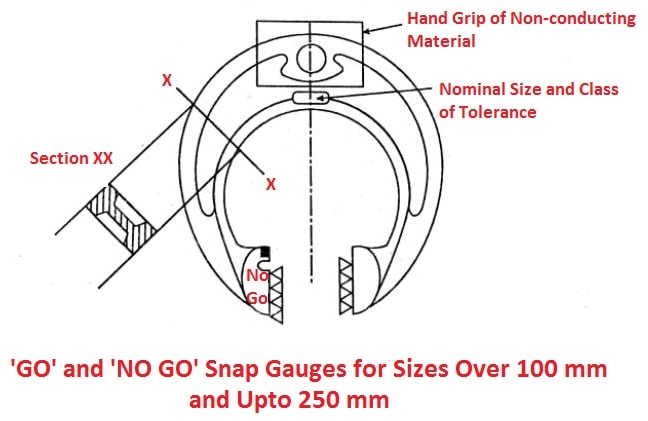
The gauging surface is hardened up to 720 H.V and suitably stabilised, ground and lapped. The other surfaces are finished smooth.
2. Plate Snap Gauges
It is a double-ended type snap gauges are used for sizes in the range of 2 to 100 mm and single-ended progressive type in the size range of 100 to 250 mm.
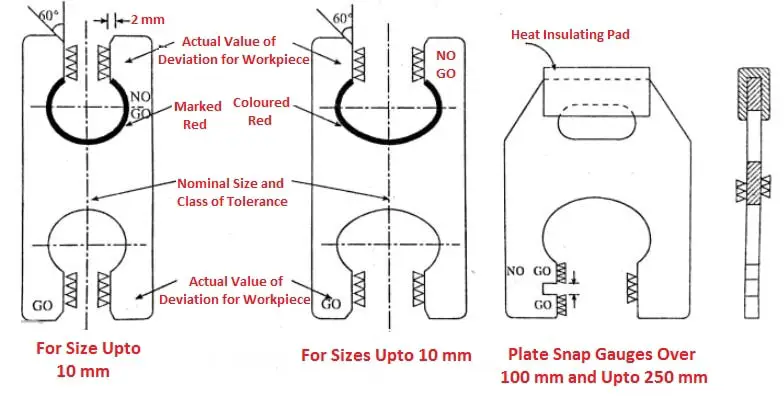
These plate snap gauges are usually made of wear-resistant steel of suitable quality. The gauging surfaces are suitably hardened, stabilized, ground and lapped. Other surfaces are smooth finished. The gauges are plainly flat and all sharp corners and edges are removed.
3. Ring Gauges
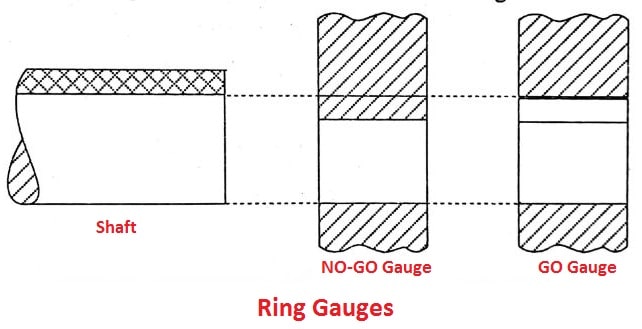
Ring gauges are limit gauges for gauging the shafts and are used in a similar manner to that of GO and NOGO plug gages. A ring gauge consists of a piece of metal in which a hole of the required size is based as shown in the figure.
4. Limit Gauges
There are several methods available to determine the dimensions of components in a system of limits and fits. The method of measurement adopted for mass production of parts is called the system of limit gauging. It has an advantage that it can be operated by unskilled persons.
Instead of measuring actual dimensions, the conformance of product with tolerance specifications can be checked by a ‘GO’ and ‘NOT GO’ gauges. These gauges represent the limit sizes of the workpiece, as per the specified product tolerances.
A GO gauge represents the maximum material condition of the product and conversely, a “NOT GO” gauge represents the minimum material condition.
5. Pin Gauges
When the holes to be checked are larger than 75 mm, such as an automobile cylinder, it is available to use a pin gauge as shown in the figure.
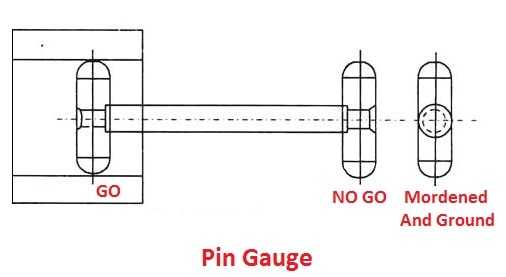
During the measurement, the gauge is located lengthwise in the cylinder bore and measurement is done. These types of gauges are particularly useful in the measurement of grooves or slot widths.
6. Calliper Gauges
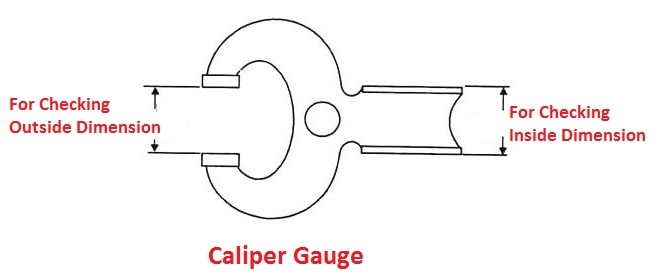
A calliper gauge is similar to a snap gauge but it is used to check both the inside and outside dimensions of the product. One end of calliper gauge checks the inside dimensions (hole diameter), while the other end measures the outside dimensions (shaft diameter).
7. Feeler Gauge
It is also known as a thickness gauge. Feeler gauges are often used to measure the clearance between the components. These gauges are excellent for the measurement of narrow slots, measuring clearance, determining small spacing, and determining the fit between mating parts.
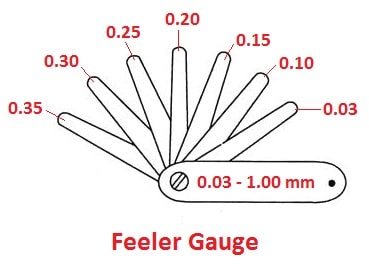
An extensive application of the filler gauge is to adjust the spark gap between the distributor points of a vehicle. This types of gauges are made of a set of narrow strips or blades of a sheet of marked thickness on each strip.
Read also: Spark Plug: Types, Parts, Working Principle, Spark plug gap.
The whole set consists of a number of strips of various thickness that are assembled together. The width of each strip is commonly prepared up to 12.5 mm. During the usage, it is essential that the blade should neither be forced nor slide smoothly between the mating parts.
8. Screw Pitch Gauges
The screw pitch gauge is also called a thread gauge which looks related to a filler gauge. Each strip or blade has several teeth, precisely shaped in standard thread form.
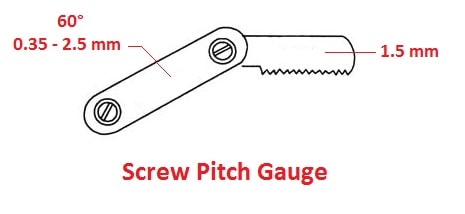
They are used to check the pitch of screw threads. They are available with thread angles involving 55° and 60°. The screw pitch gauges are similarly available in metric and inch pitches.
9. Radius or Fillet Gauge
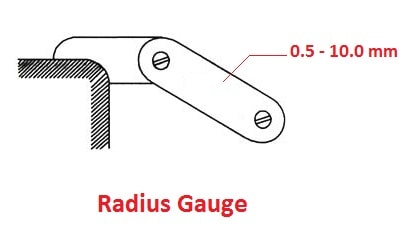
These gauge types are used to check the concave and convex radii on corners or shoulders. It is also useful for layout work and inspection of components in various industries. It is used as a template when grinding cutting tools.
That’s it, thanks for reading. We have discussed all types of gauges used in industries. But if you still have any questions about “types of gauges” then you can ask us in the comments. If you like this article on gauges then please share it with your friends. If you want more of this then please check out our blog.
Subscribe to our newsletter to get the latest article notification.
Download PDF of this article:
Read Next:
Sir pl send me PDF file I need clipper gauge which I use for cylindrical measure fixed and non fixed type. I need gauging of cylinder same cylinder have different outer dia bigger from top & bottom and have low dia in center.
The PDF file has been sent to your inbox.
Sir please send me PDF file of this Article
The PDF file has been sent to your inbox.
Excellent article. I want to thank you for this informative read, I really appreciate showing this great post keep up your work.
Keep Updating,
I’m glad you liked our article. Sure, we’ll do.
I am diploma holder and I want to get knowledge from your website
Keep visiting 🙂